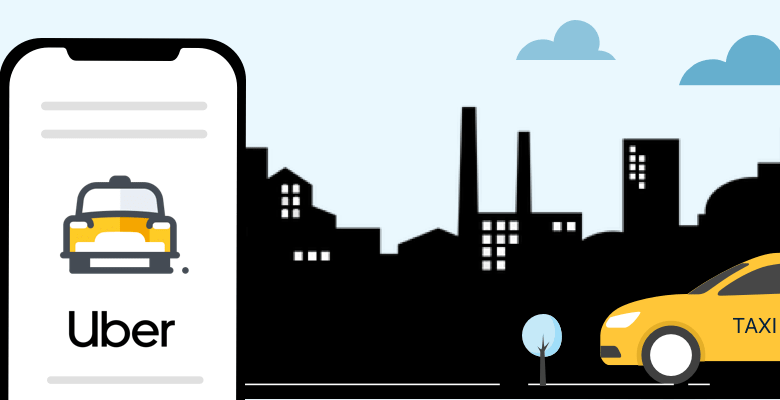How Does AI Influence Uber-Like App Development?

The incorporation of artificial intelligence (AI) into mobile applications, particularly ride-hailing services like Uber, has transformed how these platforms operate. AI-powered innovations are not only enhancing the user experience but also optimizing the backend procedures, making ride-hailing applications more efficient, customized, and future-ready. From predictive analytics to autonomous vehicles, AI is fundamentally transforming every aspect of these platforms, pushing the limits of what’s possible in the ride-hailing industry. In this blog, we will explore how AI is redefining Uber-like app development, its benefits, challenges, and the future prospects for integrating AI into these platforms.
1. AI-Powered Personalization
One of the most significant influences of AI on Uber-like apps is the ability to provide personalized services. AI algorithms analyze user behavior, ride preferences, and previous data to deliver a tailored experience. This personalization extends to several aspects:
- Customized Ride Preferences: AI systems can learn from a user’s ride history to suggest preferred routes, vehicle types, and even preferred drivers. For example, a user who frequently selects a luxury vehicle or a specific driver can have these preferences set automatically for future rides.
- Tailored Promotions: AI can segment users based on their behavior and provide personalized promotions, discounts, or loyalty rewards, increasing customer satisfaction and retention.
- Smart Route Suggestions: By analyzing patterns in user habits and external factors (like traffic or weather conditions), AI can recommend better routes or optimize scheduling to reduce waiting times.
2. Predictive Analysis for Enhanced Operations
AI’s predictive capabilities allow Uber-like apps to foresee demand, optimize resources, and enhance overall operational efficiency. The use of predictive analytics includes:
- Demand Prediction: By analyzing historical data, real-time traffic, weather patterns, and even social events, AI can predict where and when there will be high demand for rides. This helps in better dispatching and resource allocation, reducing customer wait times and improving driver utilization.
- Surge Pricing Algorithms: AI dynamically calculates fare changes based on demand and supply. For instance, during peak times or bad weather, AI adjusts prices in real-time, benefiting both drivers and the platform by ensuring availability and profitability.
- Maintenance Prediction for Vehicles: AI helps monitor vehicle health and predict when maintenance or repairs might be required, ensuring safety and reducing downtime.
3. Smart Routing and Traffic Management
Efficient navigation is key for any ride-hailing app, and AI plays a crucial role in optimizing routes. AI integrates with GPS systems, real-time traffic data, and historical traffic patterns to provide drivers with the most efficient routes, helping to:
- Reduce Travel Time: AI can predict traffic bottlenecks and suggest alternate routes, ensuring faster arrival times for passengers.
- Fuel Efficiency: By optimizing routes, AI reduces the distance traveled unnecessarily, lowering fuel consumption, which benefits drivers and contributes to the platform’s sustainability goals.
- Traffic Incident Prediction: Machine learning models can predict potential traffic disruptions, accidents, or delays, allowing drivers to avoid problem areas and deliver smoother rides.
4. AI-Enhanced Customer Service
Chatbots and AI-driven virtual assistants have become essential in handling customer service operations for Uber-like apps. They can provide quick and accurate responses to user queries, manage booking issues, and resolve common concerns without human intervention. Key contributions of AI to customer service include:
- 24/7 Availability: AI-powered chatbots provide round-the-clock support, answering frequently asked questions, helping with bookings, cancellations, and managing complaints.
- Improved Accuracy in Issue Resolution: By leveraging AI’s natural language processing (NLP) capabilities, chatbots can understand and respond to a wide range of customer issues with precision.
- Voice-Based Commands: Integrating AI into voice recognition systems allows users to interact with the app hands-free, enabling them to book rides or inquire about ride details through voice commands.
5. Fraud Detection and Enhanced Security
AI systems are integral to detecting fraud and ensuring the security of both users and drivers on the platform. AI-based algorithms continuously scan transaction patterns, user behavior, and booking anomalies to identify potentially fraudulent activities, such as:
- Fake Accounts and Ride Fraud: AI can identify fake user or driver accounts by detecting irregularities in profile data, booking patterns, or payment anomalies.
- Real-Time Fraud Prevention: Machine learning models can flag and prevent fraudulent transactions or suspicious activities, such as unauthorized access or unusual spending behavior, in real-time.
- Driver and Passenger Safety: AI is increasingly being used to monitor driver behavior during rides (e.g., sudden braking, overspeeding) and ensure compliance with safety protocols. The system can alert the app or authorities if there are any breaches, ensuring a safer experience for users.
6. AI-Driven Automation in Dispatch Systems
One of the core functionalities of Uber-like apps is the dispatch system, which connects riders with available drivers. AI plays a critical role in improving the efficiency and accuracy of dispatch operations:
- Automated Driver Allocation: AI-based algorithms allocate drivers based on proximity, traffic conditions, and predicted arrival times. This reduces idle time for drivers and wait time for passengers.
- Optimized Fleet Management: For platforms that operate their own fleets, AI systems help manage driver schedules, route planning, and vehicle usage to maximize efficiency.
- Multi-Stop Optimization: Some users may request multi-stop rides, and AI helps optimize these rides by suggesting the most efficient sequence of stops to minimize total travel time.
7. Driver Assistance and Behavior Monitoring
AI technologies like machine learning and computer vision help improve driver performance and safety. By using in-app AI tools, drivers benefit from features such as:
- Driving Pattern Monitoring: AI can monitor and evaluate driving behaviors (speeding, hard braking, rapid acceleration) and provide feedback or warnings to improve driving habits.
- Driver Fatigue Detection: Some advanced AI systems can use facial recognition and in-cabin sensors to detect signs of driver fatigue or drowsiness. The system can then alert the driver or suggest a break to prevent accidents.
- Assisted Navigation and Hazard Detection: AI-powered Advanced Driver Assistance Systems (ADAS) can enhance navigation and help drivers identify hazards on the road, such as pedestrians or obstacles, in real-time.
8. Data-Driven Decision Making
AI enables Uber-like platforms to leverage big data for informed decision-making. With the vast amount of data generated daily from ride histories, traffic patterns, and user behavior, AI algorithms help analyze this data for actionable insights, such as:
- Identifying Trends: AI can analyze user feedback, ride patterns, and customer satisfaction scores to identify trends that can improve services.
- Driver and Passenger Matching: By analyzing both driver and rider data, AI can match passengers with drivers based on preferences, location, and past ratings, ensuring a better experience for both parties.
- Dynamic Adjustments: AI-powered data analytics allow real-time adjustments, whether it’s adjusting pricing strategies, changing marketing efforts, or managing fleet availability based on current demand.
9. Autonomous Vehicles and the Future of Ride-Hailing
AI is also a key enabler of autonomous vehicle (AV) technology, which is set to transform the ride-hailing industry. Although still in the experimental phase, the integration of AI-powered AVs will significantly reduce the need for human drivers and make Uber-like platforms more scalable and cost-effective. AI in this context contributes by:
- Self-Driving Capabilities: AI systems in AVs enable them to perceive the environment, make real-time driving decisions, and navigate safely without human intervention.
- Fleet Management for AVs: AI will optimize the deployment of autonomous fleets, ensuring that AVs are sent where they’re most needed based on demand prediction and traffic analysis.
- Safety and Efficiency: AVs powered by AI are expected to reduce accidents, improve fuel efficiency, and lower the overall operational costs for ride-hailing platforms.
10. Challenges and Ethical Considerations
Despite its numerous benefits, integrating AI into Uber-like apps also presents challenges and ethical considerations:
- Data Privacy: AI systems rely on large amounts of user data for personalization and optimization. Ensuring this data is stored and processed securely while maintaining user privacy is critical.
- Bias in AI Models: AI models must be trained on diverse datasets to avoid biases that could lead to unfair treatment of certain user groups, whether it’s in ride allocation or pricing algorithms.
- Job Displacement: The advent of autonomous vehicles and increasing automation might lead to job losses for human drivers, which presents a socio-economic challenge for the industry.
Conclusion
AI’s influence on Uber-like app development is substantial and far-reaching. From enhancing personalization and customer service to improving safety, routing, and fraud detection, AI-powered solutions are enabling ride-hailing platforms to function more effectively and provide better user experiences. As technology advances, we can anticipate AI to play an increasingly more important role, especially with the emergence of self-driving cars and subsequent improvements in machine learning, making the future of Uber-like applications more inventive, intelligent, and accessible.





